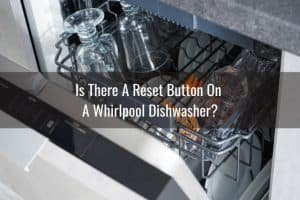
The “Oe” error code generally points to a problem with the dishwasher’s drainage. In simpler terms, your dishwasher is having trouble getting rid of the dirty water. Think of it like trying to empty a tub but the drain is blocked and water starts pooling up. In many cases, a quick reset may be just what you need to get things back on track. However, resetting is not always the magic fix. Let’s dive deeper into what this error signifies and how you can address it effectively.
Understanding the “Oe” Error Code
The “Oe” error code is Whirlpool’s way of signaling that something is wrong with your dishwasher’s drainage system. Imagine if you were trying to empty a sink full of water, but the drain was clogged, causing water to back up and spill over. That’s essentially what’s happening inside your dishwasher when you see this error. The appliance is struggling to drain the water after a cycle, which can lead to standing water at the bottom of the machine.
Common causes for this issue include clogged filters, blocked drain hoses, or even a faulty drain pump. Just like how a blocked garden hose can prevent water from flowing, a blocked drain hose in your dishwasher stops it from working properly. Sometimes, food particles or debris can build up and cause a blockage. Knowing this, it often becomes a question of whether a reset can clear these blockages or if a more hands-on approach is required.
When you see the “Oe” error code, it’s important to remain calm and methodical. Consider this your dishwasher’s cry for help. It’s its way of saying, “Hey, something’s not right here!” Before jumping into more complex solutions, starting with a reset can be a simple and effective first step in addressing the issue.
How to Reset a Whirlpool Dishwasher
So, you’re thinking a reset might fix it. Here’s the deal: resetting a Whirlpool dishwasher can sometimes clear minor glitches and restore normal function. Think of it as giving your computer a quick restart when it’s acting sluggish. The process is straightforward and doesn’t require any special tools.
First, locate your dishwasher’s reset button or control panel. It’s usually on the front, where the cycle buttons are. Sometimes, it’s a combination of two buttons that need to be pressed together. Check the user manual if you’re unsure. Once you’ve found it, press and hold the reset button for a few seconds. This action will prompt the machine to reboot and, hopefully, clear the error.
If the error persists after a reset, it’s a sign that the problem might be more than just a glitch. This doesn’t mean you’re out of options, though. Think of resetting as giving your dishwasher a moment to catch its breath. If that doesn’t solve the issue, it’s time to roll up your sleeves and look for physical blockages or malfunctions.
When Resetting Isn’t Enough: Further Troubleshooting
If the “Oe” error code sticks around even after you’ve tried resetting your dishwasher, it’s time to investigate further. Imagine if a traffic light kept flashing and resetting didn’t work; you’d need to figure out if there’s an actual traffic jam or malfunction. Similarly, you’ll need to check your dishwasher for blockages or damage.
Start by inspecting the dishwasher’s filter and drain area. Remove any visible debris that might be causing a clog. The filter can be found at the bottom of the dishwasher and is usually easy to take out. Clean it under running water to remove any gunk.
Next, check the drain hose at the back of the appliance. Ensure it’s not kinked, bent, or obstructed. Picture it like a garden hose; a kink can prevent water from passing through efficiently. If you find any blockages, clear them out before running another cycle.
If everything seems clear but the error persists, the issue might lie with the drain pump. This will likely require professional help, as dealing with electrical components can be risky. Remember, safety first! If you’re uncomfortable with any part of the process, it’s always best to call in a professional.
Preventing Future “Oe” Error Codes
So, you’ve tackled the error, and your dishwasher is up and running again. But how do you prevent the pesky “Oe” error from returning? Regular maintenance and a few preventive measures can keep your dishwasher in tip-top shape and potentially save you from the hassle of future error codes.
Consider regularly cleaning the filters and checking for blockages as part of your kitchen clean-up routine. Just as you wouldn’t let your kitchen sink get clogged, think of your dishwasher in the same way. Keeping it clear of debris ensures water can flow unimpeded.
Also, be mindful of what you’re putting into your dishwasher. Scrape off excess food from dishes before loading them in. Like avoiding pouring oil down the sink to prevent clogs, preventing large food particles from going into your dishwasher helps avoid the build-up.
Lastly, running your dishwasher with a cleaner designed for these appliances every few months can help remove any residual grease or grime. Keeping it clean ensures it operates smoothly and reduces the risk of errors. If you keep up with these simple tasks, your Whirlpool dishwasher should continue to run efficiently without any hiccups.